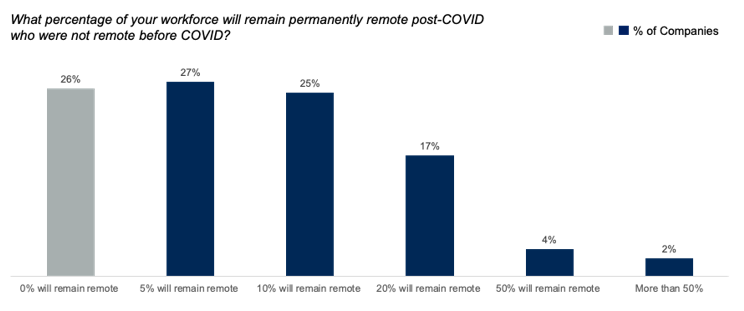Cybersecurity Software and Securing the Remote Workforce
It is estimated that 34 percent of workers are currently working from home as states reemerge from lockdowns. According to recent Gartner research, many of those workers will never return to the office. Instead they will permanently transition to a remote work environment or likely working from home. Gartner surveyed 317 CFOs and Finance leaders on March 30, 2020, and found that 74% will move at least 5% of their previously on-site workforce to permanently remote positions after COVID-19. And nearly a quarter of respondents stated they will move at least 20% of their on-site workforce to permanent remote positions.

While remote work may be a creative cost-saving opportunity for CFOs, it can lead to increased security concerns for IT teams. So while CFOs are potentially saving $30bn a day during the COVID-19 pandemic, security teams are figuring out how to secure a distributed workforce while maintaining business continuity. Let’s take a look at some of the most common tools IT teams are using to secure the new work-from-home normal.
DNS Filtering and Multi-Factor Authentication
One primary concern for security teams when it comes to managing a remote workforce is how to protect against ransomware, phishing and other attacks while users connect from public networks. Phishing remains a top security threat as off the shelf phishing kits and phishing-as-a-service (PaaS) utilities become more prolific. As we’ve seen from Verizon’s 2019 Data Breach Investigation Report, 32% of all data breaches involved phishing. Security software, such as WatchGuard’s Passport, is designed to control these threats even in a remote work environment. Passport is a user-focused security service designed to block phishing attempts, enforce web policy, protect confidential information, and authenticate people anywhere in the world. Passport provides the cloud-delivered security your users need to work on the go including multi-factor authentication (MFA), always-on protection to block phishing attempts, and immediate response to detect and quarantine threats such as ransomware.
Passport keeps users safe by leveraging DNS level protection and content filtering through WatchGuard’s DNSWatchGo service. You can see DNSWatchGo in action in the video below.
Virtual Firewall and VPN
When even more security is needed or traffic is primarily in a virtualized environment, enterprises turn to virtual firewalls and virtual private network (VPN) software. A virtual firewall is a network appliance running completely within a virtualized environment. A virtual firewall offers the same packet filtering and monitoring a physical firewall offers but also incorporates application-level content inspection, intrusion prevention, data loss prevention and URL filtering. With real-time monitoring, multi-WAN support and scalable solutions to fit any sized business, your virtual environments can be just as secure as your physical environments. URL filtering can allow for additional cloud-based services such as Reputation Enabled Defense which assigns a reputation score to every URL so your users can be protected in real-time from sites which may have only recently been compromised, Traffic to URLs which exceed the reputation score threshold can be scanned with antivirus or dropped entirely which also improves performance as known safe sites are not redundantly scanned.



